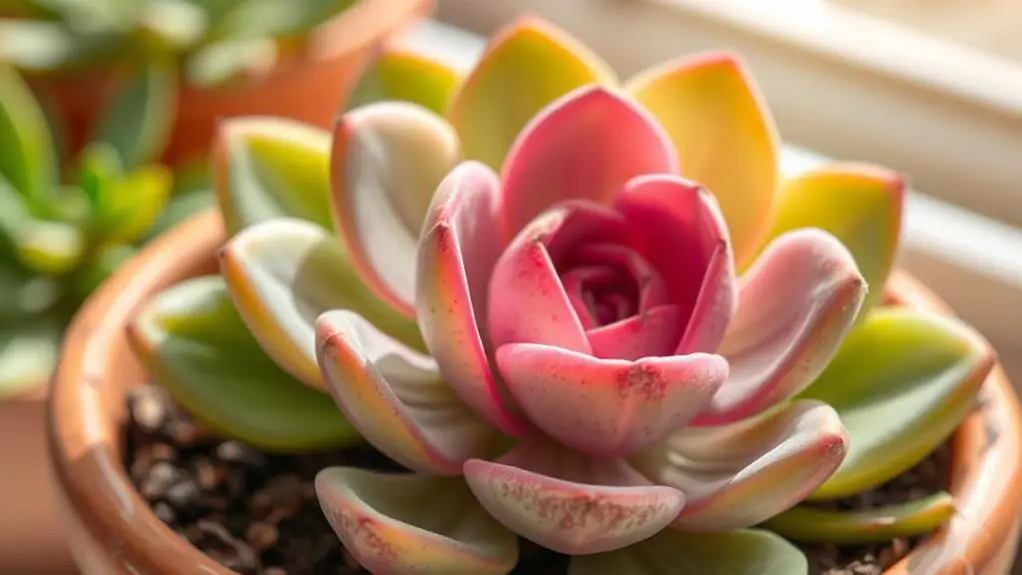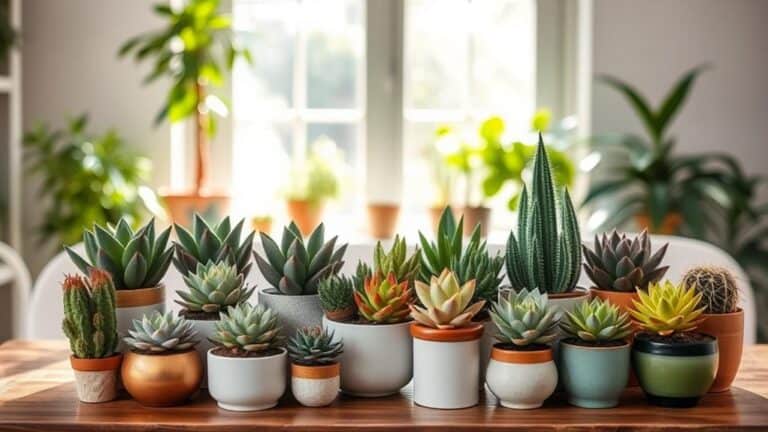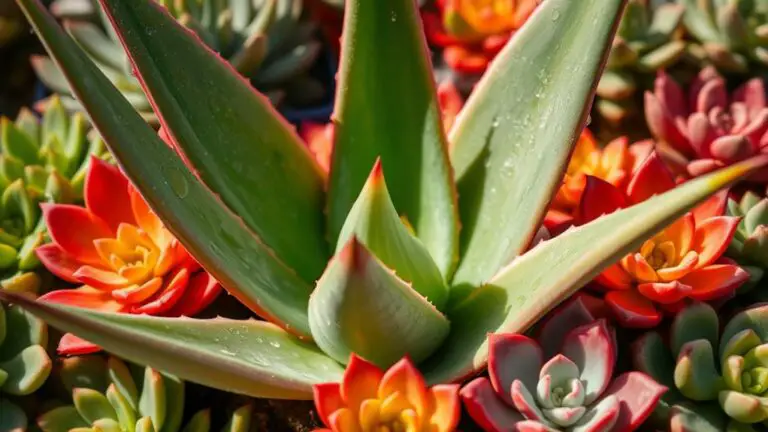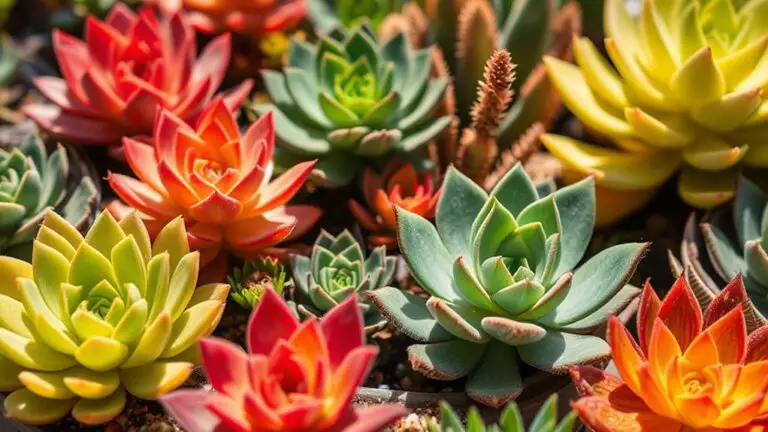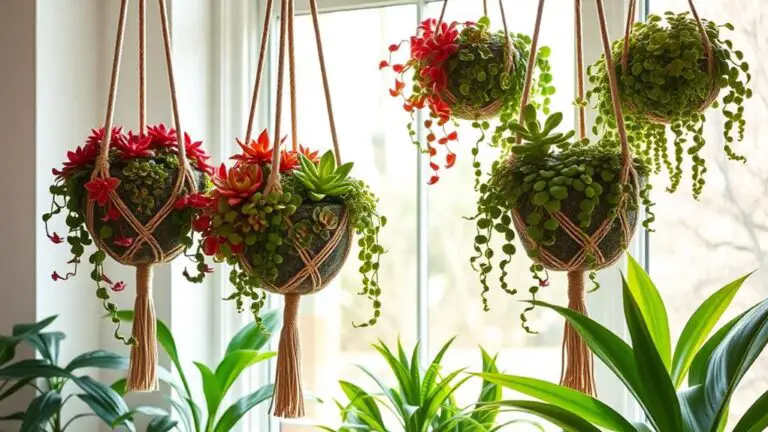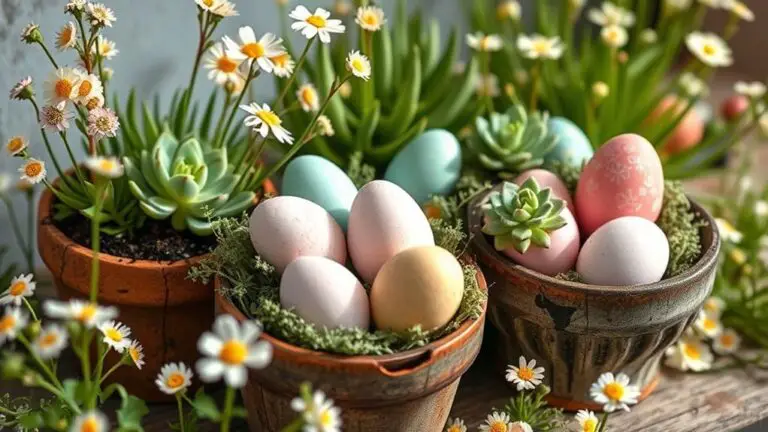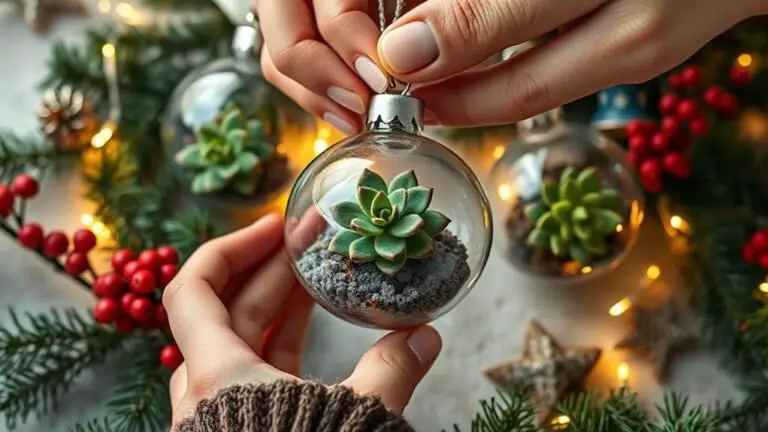Ultimate Guide to Echeveria Raindrops Care
Caring for an Echeveria Raindrops might seem intimidating at first, but with the right knowledge, you'll find it quite manageable. This guide will walk you through everything from providing the perfect light conditions to crafting the ideal soil mix. Have you ever wondered why your succulent might not be thriving despite your best efforts? Well, understanding the specifics about watering schedules and avoiding common pitfalls can make a world of difference. Stick around to discover the key elements that will guarantee your Echeveria Raindrops not only survives but flourishes in your care.
Characteristics
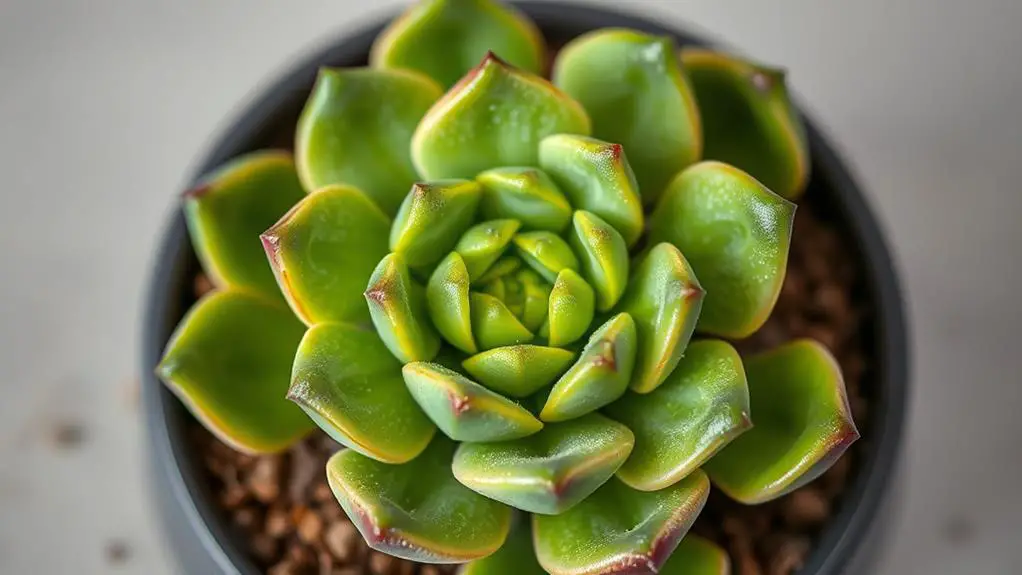
Echeveria Raindrops is an enchanting hybrid succulent developed by Dick Wright, known for its distinctive bumpy leaves that look like water droplets. These beautiful succulents form tight rosettes with spoon-shaped leaves, ranging in color from blue-green to light green.
When you see the bumpy texture on the leaves, it's like spotting tiny raindrops frozen in time. It's truly a unique feature that sets this plant apart.
Mature Echeveria Raindrops can grow up to 6 inches tall, making it a compact yet striking addition to your plant collection. The plant grows quickly, especially when you provide it with the right nutrients.
Use well-draining soil to guarantee your succulent thrives, as it helps prevent root rot and other issues.
In late spring, you'll be treated to the sight of bell-shaped flowers blooming from your Echeveria Raindrops. These flowers can vary in color from white to pink, adding an extra layer of beauty to your garden.
Plus, this succulent is non-toxic to pets and humans, so it's safe for everyone in your household. With its unique appearance and easy care, Echeveria Raindrops is a delightful and rewarding plant to grow.
Light Requirements
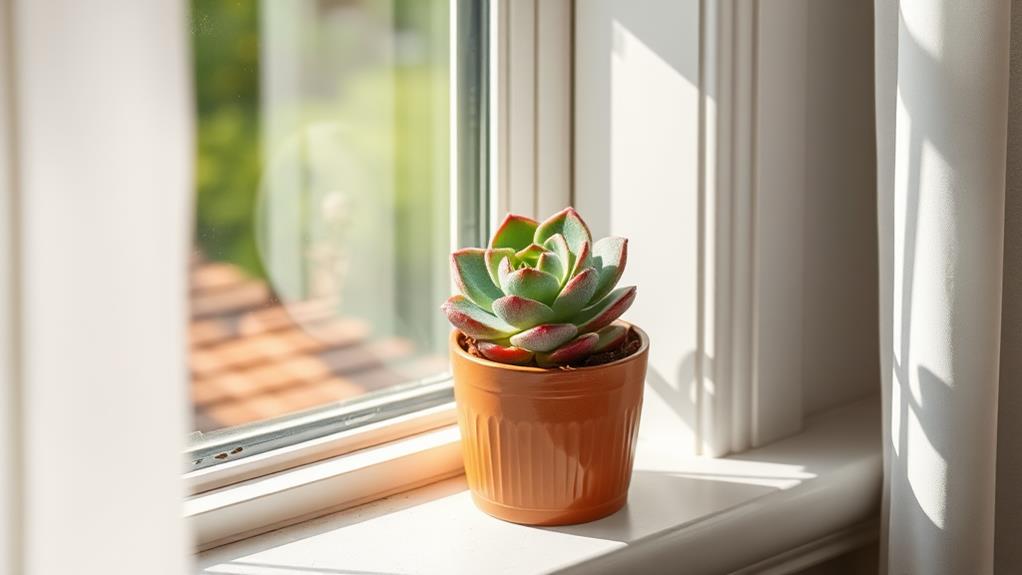
To keep your Echeveria Raindrops happy, place it in bright, direct sunlight, preferably near a south-facing window.
If you notice your plant struggling in low light, gradually increase its exposure to prevent light stress.
Optimal Sunlight Conditions
Bright, direct sunlight is vital for the growth and health of your Echeveria Raindrops. For ideal sunlight conditions, place your plant less than a foot from a south-facing window. This succulent thrives in bright sunlight, and while it can tolerate full to partial sun, it really flourishes with abundant light. Under these conditions, your Echeveria Raindrops may even change color to a lovely pink or red, adding to its visual charm.
Here's a quick guide:
| Light Condition | Effect on Plant |
|---|---|
| Bright, Direct Sun | Ideal growth and vibrant color |
| Full Sun | Thrives, may need acclimation |
| Partial Sun | Grows, but less vibrant |
Insufficient light can lead to problems like elongated stems, which isn't ideal. As a result, it's essential to make certain your plant gets the light it needs. Remember, you should avoid sudden changes in light exposure. Acclimating the plant gradually helps prevent stress and potential damage.
During its blooming season in late spring and summer, your Echeveria Raindrops will especially appreciate the sunlight. So, keep it in a spot where it can soak up those rays, and you'll see it thrive beautifully.
Light Adjustment Tips
While ideal sunlight conditions are fundamental for your Echeveria Raindrops, knowing how to adjust the light exposure is equally important. This succulent thrives in bright, direct sunlight, so placing it less than one foot from a south-facing window is a great start.
However, you need to be mindful of seasonal changes and how they affect light levels.
Here are some light adjustment tips to help you care for your Echeveria Raindrops:
- Monitor Seasonal Shifts: Adjust the plant's placement as light levels change with the seasons. In winter, move it closer to the window for more light; in summer, pull it back to avoid harsh afternoon rays.
- Gradual Changes: Introduce new light conditions slowly to prevent stress. Sudden shifts can harm the plant's health, so make changes over a few days or weeks.
- Morning Sun, Afternoon Shade: Allow it some morning direct sunlight, which is gentler and beneficial. Protect it from the intense afternoon sun to prevent leaf scorching.
Preventing Light Stress
Preventing light stress is essential for maintaining the health and vibrancy of your Echeveria Raindrops. This plant thrives in bright, direct sunlight, so placing it less than a foot from a south-facing window is ideal. This positioning guarantees your plant gets the light it needs for peak growth and blooming.
However, low-light conditions can cause stretching and weakened stems, so it's important to adjust the plant's location based on seasonal sunlight changes.
When exposed to full sunlight, Echeveria Raindrops' leaves may change color to pink or red, a sign of healthy light exposure. This color change also enhances the plant's visual appeal.
To prevent light stress, avoid sudden changes in light intensity. Instead, shift your plant gradually to new light conditions to minimize shock.
Although Echeveria Raindrops loves bright, direct sunlight, it also does well in bright, indirect light. This makes it suitable for indoor environments and well-lit areas in your home or garden.
Keep an eye on new growth and soil moisture levels, adjusting as necessary to guarantee your plant stays healthy. By following these tips, you'll help your Echeveria Raindrops thrive without experiencing light stress.
Watering Schedule

To keep your Echeveria Raindrops healthy, water it about every two weeks, letting the soil dry out completely between waterings.
In the winter, cut back to watering once a month since the plant needs less moisture.
Always water at the soil level to avoid wetting the leaves and use well-draining soil to prevent overwatering.
Frequency and Amount
Understanding the proper watering schedule is vital for the health of your Echeveria Raindrops. Watering frequency plays an important role in keeping your succulent thriving. Generally, you should water your Echeveria Raindrops once every two weeks. Confirm the soil is completely dry before the next watering to prevent root rot. Using well-draining potting soil mixed with perlite or sand helps guarantee excess moisture doesn't accumulate.
Here's a quick guide to help you:
- Check the soil: Use your finger to test if the potting soil is completely dry before watering again.
- Target the soil: Always aim the water directly at the soil, avoiding the leaves to minimize the risk of rot.
- Adjust as needed: Monitor the environment; factors like humidity and temperature might require you to tweak the schedule.
During the winter months, your Echeveria Raindrops enters a dormant phase. Reduce the watering frequency by half to about once every three to four weeks.
Maintaining this schedule guarantees your plant stays healthy and vibrant. Remember, understanding and adjusting your watering routine is key to preventing root rot and keeping your Echeveria Raindrops in top condition.
Seasonal Adjustments
Your Echeveria Raindrops' watering needs change with the seasons. During the growing season, which includes spring and summer, you should water your plant every 2-3 weeks. Verify the soil is dry before watering again to prevent root rot. This period is when your Echeveria is actively growing and needs more moisture.
In contrast, during winter dormancy, your Echeveria requires much less water. Reduce the watering frequency to once every 4-6 weeks. Plants need less moisture in winter because they're not actively growing. Always check the soil moisture before watering; if the soil is still damp, wait a few more days.
Adjust your watering schedule based on environmental factors like humidity and temperature. For instance, during a particularly hot spell, you might need to water a bit more frequently. The key is to verify the soil remains well-draining to maintain the proper moisture level for your plant.
Here's a quick reference table to help you:
| Season | Watering Frequency |
|---|---|
| Spring | Every 2-3 weeks |
| Summer | Every 2-3 weeks |
| Fall | Every 4-6 weeks |
| Winter | Every 4-6 weeks |
| Extreme Weather | Adjust as needed |
Soil and Fertilizer
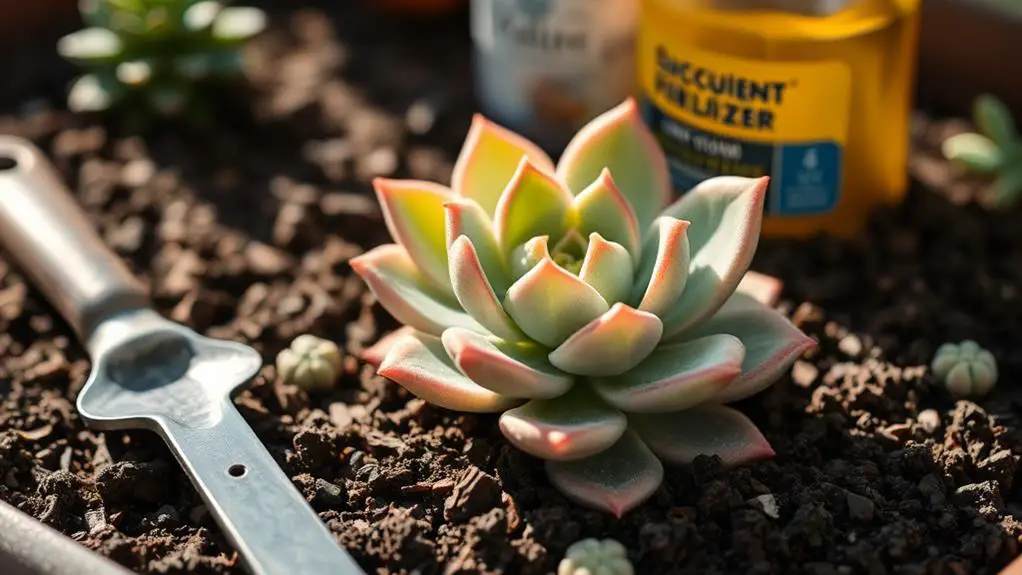
For thriving Echeveria Raindrops, you'll need well-draining soil, ideally a mix of potting soil and mineral grit like perlite, pumice, or sand in a 1:1 ratio. This soil mix prevents root rot by guaranteeing excess water drains away quickly.
Let the soil dry completely between waterings, typically every 2-3 weeks, to keep your plant healthy and avoid soggy conditions that can harm new roots.
To help you remember the key points:
- Soil Mix: Combine potting soil and mineral grit (perlite, pumice, or sand) in equal parts.
- Watering Schedule: Allow the soil to dry out completely between waterings, about every 2-3 weeks.
- Soil pH: Guarantee it stays between 6.0 and 7.0.
Fertilization isn't generally necessary for Echeveria Raindrops since they get nutrients from fresh potting soil. However, if you want to give them a boost, use a half-strength balanced liquid fertilizer every 4-6 weeks during the growing season.
Repot your plant when it doubles in size or annually to replenish nutrients and maintain a healthy growth environment. By doing so, you'll guarantee your Echeveria Raindrops thrives and continues to grow beautifully.
Keep these tips in mind, and you'll be well on your way to successful succulent care.
Propagation Methods
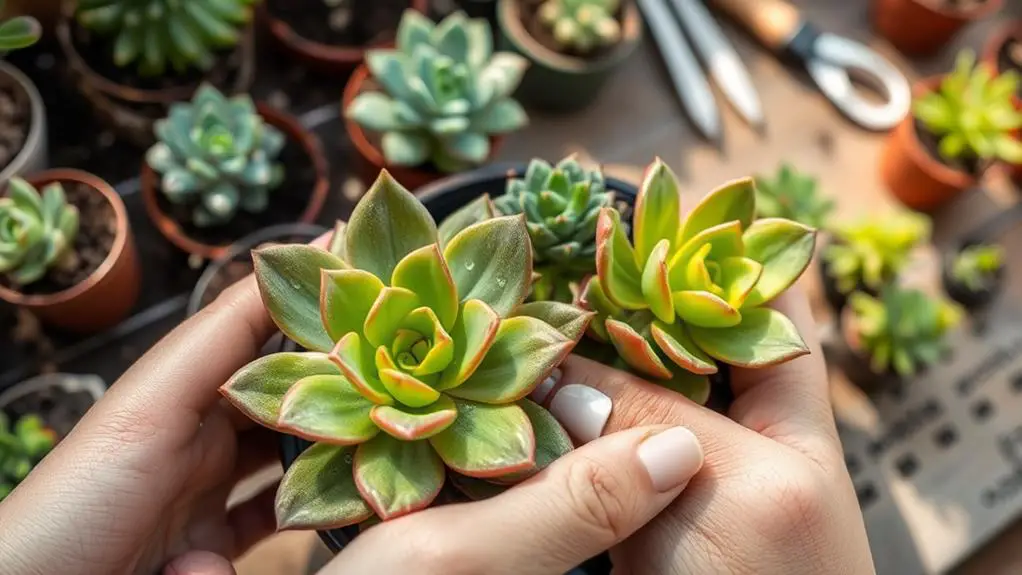
When it comes to propagating Echeveria Raindrops, one of the most reliable methods is through leaf cuttings.
You'll start by gently twisting a healthy leaf from the stem. Make certain you get a clean break without damaging the base of the mother plant. Next, allow it to callus for a few days. This helps prevent rot when you plant it.
Once the leaf has callused, place it on well-draining soil. A mix of potting soil and perlite or sand works great. Lightly mist the soil to keep it moist but not soggy. Over the next few weeks, the leaf will start to produce new roots and eventually a tiny rosette.
Another way to propagate new Echeveria Raindrops is by using offsets, or "pups," that grow at the base of the mother plant.
Carefully remove these with a knife and let them callus for a couple of days before planting.
Lastly, you can collect seeds from mature flowers, though this method takes more time and care.
Regardless of the method, make sure your cuttings or offsets are in a quick-draining mix to avoid root rot.
Happy propagating!
Common Issues

Caring for Echeveria Raindrops isn't without its challenges. You might face issues like overwatering, root rot, pest infestations, and nutrient deficiencies, but don't worry—there are ways to handle them.
Overwatering is a common problem. If you notice soft, discolored leaves, it could be a sign of root rot. To fix this, cut above the affected area, let it dry, and replant in fresh, well-draining soil.
Pest infestations are another issue. Mealybugs, aphids, and spider mites can wreak havoc on your plant. Regularly inspect your Echeveria Raindrops and, if you spot pests, use rubbing alcohol on a cotton swab to remove them.
Nutrient deficiencies can also occur. Yellowing leaves often indicate your plant needs better soil or more sunlight. Adjust the light or consider repotting with nutrient-rich soil.
Here's a quick checklist to help you keep your Echeveria Raindrops healthy:
- Overwatering: Confirm the soil dries out between waterings.
- Pest infestations: Regularly check for pests and treat promptly.
- Nutrient deficiencies: Monitor for yellowing leaves and adjust soil or light.
Frequently Asked Questions
How Do You Care for Echeveria Raindrop?
Place your Echeveria Raindrop near a south-facing window for bright light. Water sparingly, letting soil dry completely between watering. Use well-draining soil, watch for pests, and reduce watering during winter dormancy to prevent root rot.
Are Echeveria Raindrops Rare?
Echeveria Raindrops aren't extremely rare, but they're not as common as other succulents. Their unique, bumpy leaves and limited availability make them a sought-after choice for collectors, adding to their perceived rarity among enthusiasts.
How Often Do You Water Echeveria Laui?
You should water Echeveria Laui every 2 to 3 weeks, letting the soil dry out completely between waterings. During winter dormancy, cut watering in half. Always check soil dryness 1-2 inches below the surface before watering.
What Does an Overwatered Echeveria Look Like?
An overwatered Echeveria shows soft, mushy, and sometimes translucent leaves. You might notice yellowing, a foul odor from the soil, or dark, mushy roots. Let the soil dry out completely and guarantee proper drainage.
Conclusion
By following these tips, you'll have a beautiful and healthy Echeveria Raindrops. Remember to give it plenty of sunlight, water it just right, and use well-draining soil. Don't forget to fertilize sparingly and watch for pests. With a little care and attention, your plant will thrive. If you ever face issues, just refer back to this guide. You've got this! Happy gardening and enjoy your lovely Echeveria Raindrops!

